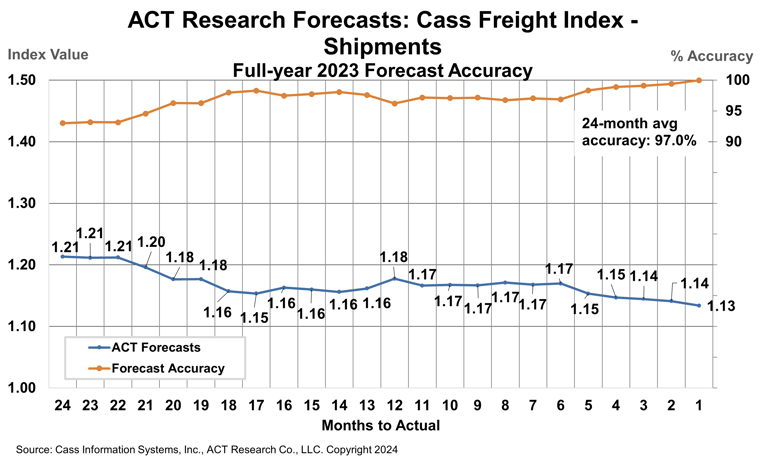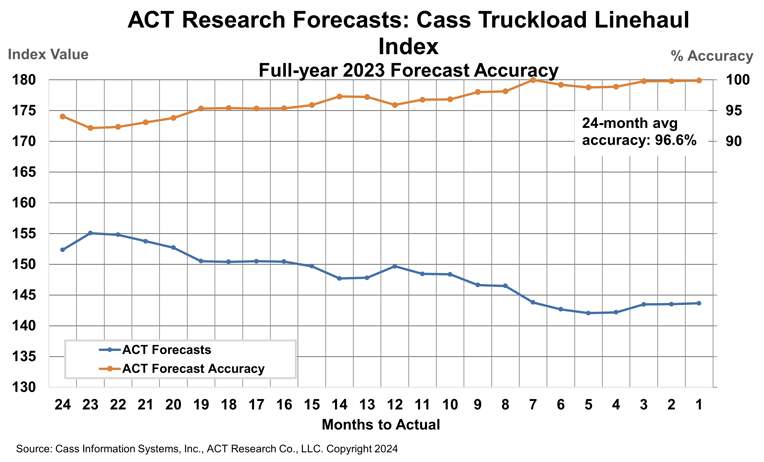Get the most up-to-date data and insights into shipping volumes and the cost of freight. See how they change each month and understand the market forces behind them.
| October 2024 | Year-over-year change | 2-year stacked change | Month-to-month change | Month-to-month change (SA*) | |
| Cass Freight Index - Shipments | 1.081 | -2.4% | -11.7% | -1.9% | -0.1% |
| Cass Freight Index - Expenditures | 3.175 | -5.9% | -27.8% | -1.5% | -1.7% |
| Cass Inferred Freight Rates | 2.937 | -3.6% | NA | 0.4% | -1.5% |
| Truckload Linehaul Index | 138.00 | -2.2% | -10.3% | 0.7% | NA |
* SA = seasonally adjusted
The shipments component of the Cass Freight Index® fell 1.9% m/m in October, after a 1.7% decline in September.
In a sign that private fleet growth continues to affect for-hire demand, the ongoing softness in shipments comes as Class 8 tractor sales rebounded from supply constraints in Q2. Although goods demand growth is driving broad freight volume growth, as can be seen in intermodal, imports, and freight GDP, it is still not reaching the for-hire market.
After rising 13% in 2021 and 0.6% in 2022, this index declined 5.5% in 2023. With normal seasonality, the index will fall about 3% y/y in November and about 4% for the full year.

See the Methodology for the Cass Freight Index
The expenditures component of the Cass Freight Index, which measures the total amount spent on freight, fell 1.5% m/m in October, partly due to another decline in fuel prices. The y/y decline moderated to 5.9% from 6.6% in September.
With shipments down 1.9% m/m, we infer the 1.5% decrease in expenditures included rates up 0.4% m/m in October (see our inferred rates data series below).
This index includes changes in fuel, modal mix, intramodal mix, and accessorial charges, so is a bit more volatile than the cleaner Cass Truckload Linehaul Index®.
The expenditures component of the Cass Freight Index fell 19% in 2023, after a record 38% surge in 2021 and another 23% increase in 2022. It declined another 16% in 1H’24, and assuming normal seasonal patterns from here, will decline 11%-12% this year.

The rates embedded in the two components of the Cass Freight Index rose 0.4% m/m in October, after a 4.2% m/m gain in September.
Based on the normal seasonal pattern, this index will still fall 3%-4% y/y in November. The normal seasonal pattern from here would leave inferred rates down 7%-8% in 2024, with a small upward turn in Q1’25.

Cass Inferred Freight Rates are a simple calculation of the Cass Freight Index data—expenditures divided by shipments—producing a data set that explains the overall movement in cost per shipment. The data set is diversified among all modes, with truckload (TL) representing more than half of the dollars, followed by less-than-truckload (LTL), rail, parcel, and so on.
The Cass Truckload Linehaul Index, measuring changes in the linehaul component of freight costs, rose 0.7% m/m in October, the second straight small increase from a cycle-low in August.

See the Methodology for the Cass Truckload Linehaul Index
The truckload market balance as 2024 nears an end is, well, pretty balanced, but changing. As private fleet growth is slowing, it’s worth highlighting the significant capacity contraction by for-hire fleets. In Q3, we estimate the publicly traded fleets were 5.9% smaller than a year ago. While the sequential decline in tractor count slowed, the current low-margin environment is not motivating investment. Even private fleets may be realizing how much cost they’re leaving on the table. We estimate at least $1/mile savings with for-hire contract rates compared to private fleet costs, which is more than double the long-term average, part of which is structural.

Amid this for-hire supply contraction, demand is at least closing the gap. The y/y decline in the shipments component of the Cass Freight Index narrowed to 2.8% in Q3 from 5.3% in Q2’24, and even further to 2.4% in October. After a long downturn in freight rates, the difference between the 5.9% contraction in capacity and the 2.8% drop in shipments may help explain why TL rates have started to rise, if only by a little.
Our outlook through 2026 is detailed in the ACT Research Freight Forecast. This service provides in-depth analysis and forecasts for a broad range of U.S. freight measures, including the Cass Freight Index, Cass Truckload Linehaul Index, DAT spot and contract rates by trailer type, LTL, and intermodal price indexes. We provide monthly, quarterly, and annual predictions for over forty data series over a two- to three-year time horizon, including capacity, volumes, and rates. The ACT Research Freight Forecast is released monthly in conjunction with the Cass Transportation Index report.
How have ACT Research’s freight forecasts performed? For 2023, ACT’s forecasts for the shipments component of the Cass Freight Index were 96.9% accurate on average for the 24-month forecast period.
(As a reminder, ACT Research’s Tim Denoyer writes this report.)

ACT Research’s 2023 forecasts for the Cass Truckload Linehaul Index were 96.6% accurate on average over the past 24 months, and 98.5% accurate over the past 12 months. The Cass Truckload Linehaul Index averaged 143.8 in 2023, precisely in line with our July 2023 estimate.

Release date: We strive to release our indexes on the 13th of each month. When this falls on a Friday or weekend, our goal is to publish on the next business day.

Tim Denoyer joined ACT Research in 2017 after spending fifteen years in equity research focused primarily on the transportation, machinery, and automotive industries. Tim is a senior analyst leading ACT’s transportation research effort and the primary author of the ACT Freight Forecast, U.S. Rate and Volume OUTLOOK. Research associate, Carter Vieth, who joined ACT in early 2020 after graduating from Indiana University, also contributes to the report. This report provides supply-chain professionals with better visibility on the future of pricing and volume in trucking, the core of the $1.2 trillion US freight transportation industry, including TL, LTL, and intermodal.
Tim also contributes to ACT’s core Classes 4-8 commercial vehicle (CV) data analysis and forecasting; powertrain development, such as electrification analysis; and used truck valuation and forecasting. Tim has supported or led numerous project-based market studies on behalf of clients in his six years with ACT on topics ranging from upcoming emissions and environmental regulations to alternative powertrain cost analyses, to e-commerce and last-mile logistics, to autonomous freight market sizing.
ACT’s freight research service leverages its expertise in the supply-side economics of transportation and draws upon Tim’s background as an investment analyst, beginning at Prudential and Bear Stearns. Tim was a co-founder of Wolfe Research, one of the leading equity research firms in the investment industry. His experience also includes responsibility for covering the industrial sector of the global equity markets, including with leading investment management company Balyasny Asset Management.
The material contained herein is intended as general industry commentary. The Cass Freight Index, Cass Truckload Linehaul Index (“Indexes”), and other content are based upon information that we consider reliable, but Cass does not guarantee the accuracy, timeliness, reliability, continued availability or completeness of any information or underlying assumptions, and Cass shall have no liability for any errors, omissions or interruptions. Any data on past performance contained in the Indexes is no guarantee as to future performance. The Indexes and other content are not intended to predict actual results, and no assurances are given with respect thereto. Cass makes no warranty, express or implied. Opinions expressed herein as to the Indexes are those of ACT Research and may differ from those of Cass Information Systems Inc. All opinions and estimates are given as of the date hereof and are subject to change.
© Copyright 2023 Cass Information Systems, Inc.